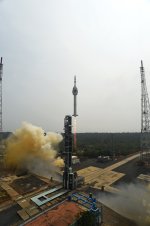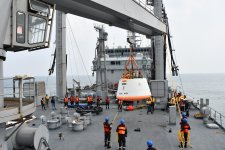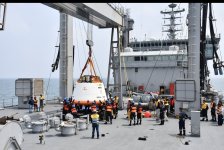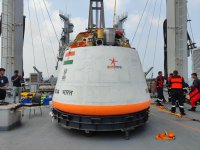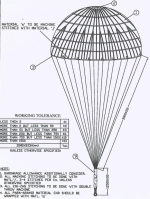Gaganyaan Mission : ISRO to send Indian into space by 2022
- Thread starter Ashwin
- Start date
You are using an out of date browser. It may not display this or other websites correctly.
You should upgrade or use an alternative browser.
You should upgrade or use an alternative browser.
Safe splashdown. IR tracking was probably by IN's P-8Is.
This is first time they used liquid propulsion launch? I kinda wondered why DRDO also despite having separate dept of liquid and air-breathing propulsion and a whole dedicated directorate, barely use it. Ever since Dr Kalam sir era, solid rockets are king.
Pilerne-based Kineco Kaman delivers key component for ISRO’s human space mission
By TNN
Dec 23, 2023, 04:28 IST

Panaji: In a major milestone for the Gaganyaan programme, Kineco Kaman supplied the first Orbiter Module Adaptor (OMA) assembly that will be used by the Indian Space Research Organisation (ISRO) for India’s first human space flight mission.
In mid-2022, the Pilerne-based firm bagged the contract to supply three composites-intensive crew OMA to the Vikram Sarabhai Space Centre (VSSC), a division of ISRO.
The OMA is a 4m-diameter conical structure made of carbon fibre-reinforced plastic that is integrated with the crew escape module and equipment bay shroud.
Chief minister Pramod Sawant lauded the development and the company’s contribution to space and lunar exploration. “We are vocal for local and also local for global. This is a proud moment for the state,” Sawant said.
ISRO officials, who were present at Kineco Kaman’s manufacturing facility said that a major milestone for the Gaganyaan programme has been met. Director-VSSC S Unnikrishnan Nair was virtually present for the event.
The completion of the OMA also marks the successful collaboration between Isro-VSSC and Kineco Kaman Composites. Kineco Kaman was picked based on its track record and consistent performance on space programmes like the supply of Dual Helix Antennas for the Indian Regional Navigational Satellite programme (IRNSS) and EBS Assembly for the LVM3-M2/OneWeb India and Chandrayaan-3 missions.
“Our technicians and engineers worked tirelessly with the VSSC scientists to meet the stringent quality parameters and demanding delivery timelines. We are thankful to the VSSC team for their continued support and partnership. We will continue to partner with Isro-VSSC to make India self-reliant in future space explorations,” said Shekhar Sardessai, founder of Kineco Group and chairman and managing director of Kineco Kaman.
Kineco Kaman manufactures advanced composite parts and assemblies for aerospace and defence customers, including global firms in the US, Europe and Israel. Kineco Kaman has supplied components to BAE Systems and is also a major supplier of composite parts and assemblies to Hindustan Aeronautics Limited.
The company said that the completion and supply of the OMA signifies a turning point in the nation’s technological journey. In 2022, Kineco Kaman became India’s first private company to successfully supply another critical component, the equipment bay shroud assembly for the GSLV Mk-III.
Pilerne-based Kineco Kaman delivers key component for Isro’s human space mission | Goa News - Times of India
By TNN
Dec 23, 2023, 04:28 IST

Panaji: In a major milestone for the Gaganyaan programme, Kineco Kaman supplied the first Orbiter Module Adaptor (OMA) assembly that will be used by the Indian Space Research Organisation (ISRO) for India’s first human space flight mission.
In mid-2022, the Pilerne-based firm bagged the contract to supply three composites-intensive crew OMA to the Vikram Sarabhai Space Centre (VSSC), a division of ISRO.
The OMA is a 4m-diameter conical structure made of carbon fibre-reinforced plastic that is integrated with the crew escape module and equipment bay shroud.
Chief minister Pramod Sawant lauded the development and the company’s contribution to space and lunar exploration. “We are vocal for local and also local for global. This is a proud moment for the state,” Sawant said.
ISRO officials, who were present at Kineco Kaman’s manufacturing facility said that a major milestone for the Gaganyaan programme has been met. Director-VSSC S Unnikrishnan Nair was virtually present for the event.
The completion of the OMA also marks the successful collaboration between Isro-VSSC and Kineco Kaman Composites. Kineco Kaman was picked based on its track record and consistent performance on space programmes like the supply of Dual Helix Antennas for the Indian Regional Navigational Satellite programme (IRNSS) and EBS Assembly for the LVM3-M2/OneWeb India and Chandrayaan-3 missions.
“Our technicians and engineers worked tirelessly with the VSSC scientists to meet the stringent quality parameters and demanding delivery timelines. We are thankful to the VSSC team for their continued support and partnership. We will continue to partner with Isro-VSSC to make India self-reliant in future space explorations,” said Shekhar Sardessai, founder of Kineco Group and chairman and managing director of Kineco Kaman.
Kineco Kaman manufactures advanced composite parts and assemblies for aerospace and defence customers, including global firms in the US, Europe and Israel. Kineco Kaman has supplied components to BAE Systems and is also a major supplier of composite parts and assemblies to Hindustan Aeronautics Limited.
The company said that the completion and supply of the OMA signifies a turning point in the nation’s technological journey. In 2022, Kineco Kaman became India’s first private company to successfully supply another critical component, the equipment bay shroud assembly for the GSLV Mk-III.
Pilerne-based Kineco Kaman delivers key component for Isro’s human space mission | Goa News - Times of India
ISRO's fuel cell tech to power Indian Space Station and quench thirst of astronauts
The Fuel Cell Power System will generate electricity that can power the space station and produce pure drinking water as a byproduct that would quench the thirst of astronauts.
By SV Krishna Chaitanya
Express News Service
Published: 01st January 2024 08:07 PM | Last Updated: 01st January 2024 08:07 PM

ISRO's PSLV-C58 carrying an X-ray polarimeter satelite and 10 other satelites lifts off from the spaceposrt of Sriharikota, Monday, Jan. 1, 2024. (Photo: ISRO)
SRIHARIKOTA: While all eyes were on the launch of XPoSat, which was India's first dedicated scientific satellite to study black holes, the Indian Space Research Organisation (ISRO) has quietly achieved another important milestone that would be vital for powering the ambitious Indian Space Station.
This was the successful demonstration of the Fuel Cell Power System (FCPS), developed by Kerala-based Vikram Sarabhai Space Centre (VSSC). A 100-watt FCPS was flown in the fourth stage of the rocket, which was used as a test bed called PSLV Orbital Experimental Module-3 (POEM) for trying out new payloads.
Among them, the FCPS was a significant payload considering its potential value in the run-up to building the Indian Space Station. The FCPS will generate electricity that can power the space station and produce pure drinking water as a byproduct that would quench the thirst of astronauts.
VSSC director S Unnikrishnan Nair told TNIE that for the first time, ISRO experimented with fuel cells in space. "FCPS generates power from oxygen and hydrogen, which are stored in high pressure and pass through fuel cell assembly. Then, the chemical reaction kicks in and generates power and water. Water here is pure and the byproduct."
ISRO chairman S Somanath confirmed to TNIE that the water generated by FCPS was pure drinkable water.
"Having a water source on board is a must when we are talking about building our own space station. Fuel cells are ideal for power generation and water. The 100-watt FCPS that we developed is successfully tested. We wanted to see how it performs in weightless conditions, radiative environment and extreme temperature. The entire system worked nicely. We have plans to build a 100-kilowatt FCPS," Nair said.
VSSC has also built FCPS and given it to agencies for ground testing. "The tests are going on. Fuel cells can be used to set up a small modular power station in inaccessible remote hilly locations," Nair told this reporter.
The International Space Station (ISS) is powered by a combination of fuel cells and solar cells. "The technology is not new. India is trying it for the first time and attempting to expand its scope and utility," an ISRO scientist said. ISRO is gearing up to launch the first module of the Indian Space Station by 2028 and make it fully operational by 2035.
This apart, ISRO also successfully demonstrated silicon based high energy cells, again developed by VSSC, during Monday's PSLV launch. These are lithium ion cells with silicon graphite as the material inside. "These cells have enhanced energy density, making them compact and lightweight. Once the technology develops, we can give it to the industry," Nair said.
ISRO's fuel cell tech to power Indian Space Station and quench thirst of astronauts
The Fuel Cell Power System will generate electricity that can power the space station and produce pure drinking water as a byproduct that would quench the thirst of astronauts.
By SV Krishna Chaitanya
Express News Service
Published: 01st January 2024 08:07 PM | Last Updated: 01st January 2024 08:07 PM

ISRO's PSLV-C58 carrying an X-ray polarimeter satelite and 10 other satelites lifts off from the spaceposrt of Sriharikota, Monday, Jan. 1, 2024. (Photo: ISRO)
SRIHARIKOTA: While all eyes were on the launch of XPoSat, which was India's first dedicated scientific satellite to study black holes, the Indian Space Research Organisation (ISRO) has quietly achieved another important milestone that would be vital for powering the ambitious Indian Space Station.
This was the successful demonstration of the Fuel Cell Power System (FCPS), developed by Kerala-based Vikram Sarabhai Space Centre (VSSC). A 100-watt FCPS was flown in the fourth stage of the rocket, which was used as a test bed called PSLV Orbital Experimental Module-3 (POEM) for trying out new payloads.
Among them, the FCPS was a significant payload considering its potential value in the run-up to building the Indian Space Station. The FCPS will generate electricity that can power the space station and produce pure drinking water as a byproduct that would quench the thirst of astronauts.
VSSC director S Unnikrishnan Nair told TNIE that for the first time, ISRO experimented with fuel cells in space. "FCPS generates power from oxygen and hydrogen, which are stored in high pressure and pass through fuel cell assembly. Then, the chemical reaction kicks in and generates power and water. Water here is pure and the byproduct."
ISRO chairman S Somanath confirmed to TNIE that the water generated by FCPS was pure drinkable water.
"Having a water source on board is a must when we are talking about building our own space station. Fuel cells are ideal for power generation and water. The 100-watt FCPS that we developed is successfully tested. We wanted to see how it performs in weightless conditions, radiative environment and extreme temperature. The entire system worked nicely. We have plans to build a 100-kilowatt FCPS," Nair said.
VSSC has also built FCPS and given it to agencies for ground testing. "The tests are going on. Fuel cells can be used to set up a small modular power station in inaccessible remote hilly locations," Nair told this reporter.
The International Space Station (ISS) is powered by a combination of fuel cells and solar cells. "The technology is not new. India is trying it for the first time and attempting to expand its scope and utility," an ISRO scientist said. ISRO is gearing up to launch the first module of the Indian Space Station by 2028 and make it fully operational by 2035.
This apart, ISRO also successfully demonstrated silicon based high energy cells, again developed by VSSC, during Monday's PSLV launch. These are lithium ion cells with silicon graphite as the material inside. "These cells have enhanced energy density, making them compact and lightweight. Once the technology develops, we can give it to the industry," Nair said.
ISRO's fuel cell tech to power Indian Space Station and quench thirst of astronauts
ISRO’s Fuel Cell flight tested in PSLV C58
January 5, 2024

Photo: Fuel cell payload.
ISRO has successfully tested a 100 W class Polymer Electrolyte Membrane Fuel Cell based Power System (FCPS) in its orbital platform, POEM3, launched onboard PSLV-C58 on January 1, 2024. The objective of the experiment was to assess Polymer Electrolyte Membrane Fuel cell operation in space and to collect data to facilitate the design of systems for future missions.
During the short duration test onboard POEM, 180 W power was generated from Hydrogen and Oxygen gases stored on onboard in high pressure vessels. It provided a wealth of data on performance of various static and dynamic systems that formed part of the power system and the physics at play.
Hydrogen Fuel Cells produce electricity directly from Hydrogen and Oxygen gases, along with pure water and heat. It is an electric generator which works on electrochemical principles, as in batteries, as against the combustion reactions employed in conventional generators. The ability to produce electricity directly from fuels without any intermediate step renders them very efficient. With water as the only byproduct, they are totally emission free. These features make them ideal candidates for space missions involving humans where electric power, water and heat are essential since a single system can meet multiple requirements in the mission.
Fuel Cells also possess significant societal application potential. They are also considered to be the most appropriate solution to replace the engines of various types of vehicles that are in use today and to power standby power systems. Fuel Cells can provide range and fuel recharge time equaling that of today’s conventional engine, which gives them a distinct advantage over batteries, and are expected to facilitate emission free transportation. Fuel cell is ideal power source for Space Station as it provides both power and pure water.
ISRO’s Fuel Cell flight tested in PSLV C58
January 5, 2024

Photo: Fuel cell payload.
ISRO has successfully tested a 100 W class Polymer Electrolyte Membrane Fuel Cell based Power System (FCPS) in its orbital platform, POEM3, launched onboard PSLV-C58 on January 1, 2024. The objective of the experiment was to assess Polymer Electrolyte Membrane Fuel cell operation in space and to collect data to facilitate the design of systems for future missions.
During the short duration test onboard POEM, 180 W power was generated from Hydrogen and Oxygen gases stored on onboard in high pressure vessels. It provided a wealth of data on performance of various static and dynamic systems that formed part of the power system and the physics at play.
Hydrogen Fuel Cells produce electricity directly from Hydrogen and Oxygen gases, along with pure water and heat. It is an electric generator which works on electrochemical principles, as in batteries, as against the combustion reactions employed in conventional generators. The ability to produce electricity directly from fuels without any intermediate step renders them very efficient. With water as the only byproduct, they are totally emission free. These features make them ideal candidates for space missions involving humans where electric power, water and heat are essential since a single system can meet multiple requirements in the mission.
Fuel Cells also possess significant societal application potential. They are also considered to be the most appropriate solution to replace the engines of various types of vehicles that are in use today and to power standby power systems. Fuel Cells can provide range and fuel recharge time equaling that of today’s conventional engine, which gives them a distinct advantage over batteries, and are expected to facilitate emission free transportation. Fuel cell is ideal power source for Space Station as it provides both power and pure water.
ISRO’s Fuel Cell flight tested in PSLV C58
Flight Demonstration of Si-Gr anode based High Energy Density Li-ion Cells
January 5, 2024
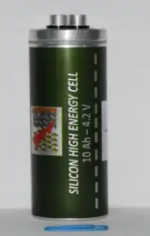
Photo: ISRO's 10 Ah Silicon-Graphite anode based High Energy Density Li-ion cells
Vikram Sarabhai Space Centre (VSSC)/ISRO has qualified 10 Ah Silicon–Graphite anode based high energy density Li-ion cells as a low weight and low cost alternative to present cells being used. The flight demonstration of the cells as a battery was successfully completed by powering a resistive load on-board the POEM-3 platform of PSLV-C58. The on-orbit voltage, current and temperature values of the battery were acquired through telemetry and found to match well with the predictions.

Photo: Li-Ion Powerpack Configuration with a total mass of 4.3 kgs.
Compared to conventional Li-ion cells which use pure graphite as anode material, this cell uses Si-Graphite composite as anode material. This helps in accommodating more Lithium ions for a given unit mass of anode material and thus improves the energy density of the cell. In addition to the material change, this cell also employs cost effective hardware which are readily available and a crimped sealing based design which reduces the hardware cost and fabrication cost significantly. The energy density of the Silicon High energy Li-ion cells is 190 Wh/kg with an operating voltage of 4.2 to 2.8 V, against Lithium-ion cells (157 Wh/kg). During flight the battery system worked for 21 hours in 15 orbits delivering a capacity of 8.9 Ah with final drained voltage of 0.4 V.
Before inducting any new systems in operational vehicles &missions, VSSC subjects the system to rigorous qualification and flight demonstration as piggy back payloads. Same approach is followed for these cells also. The capability of the cells to survive and perform in harsh space environment was also successfully demonstrated through the POEM experiment.
Based on the confidence gained through this performance, these cells are poised to be used in upcoming operational missions where 35-40% battery mass saving is expected. The system find application both in space and ground use.
Flight Demonstration of Si-Gr anode based High Energy Density Li-ion Cells
January 5, 2024

Photo: ISRO's 10 Ah Silicon-Graphite anode based High Energy Density Li-ion cells
Vikram Sarabhai Space Centre (VSSC)/ISRO has qualified 10 Ah Silicon–Graphite anode based high energy density Li-ion cells as a low weight and low cost alternative to present cells being used. The flight demonstration of the cells as a battery was successfully completed by powering a resistive load on-board the POEM-3 platform of PSLV-C58. The on-orbit voltage, current and temperature values of the battery were acquired through telemetry and found to match well with the predictions.

Photo: Li-Ion Powerpack Configuration with a total mass of 4.3 kgs.
Compared to conventional Li-ion cells which use pure graphite as anode material, this cell uses Si-Graphite composite as anode material. This helps in accommodating more Lithium ions for a given unit mass of anode material and thus improves the energy density of the cell. In addition to the material change, this cell also employs cost effective hardware which are readily available and a crimped sealing based design which reduces the hardware cost and fabrication cost significantly. The energy density of the Silicon High energy Li-ion cells is 190 Wh/kg with an operating voltage of 4.2 to 2.8 V, against Lithium-ion cells (157 Wh/kg). During flight the battery system worked for 21 hours in 15 orbits delivering a capacity of 8.9 Ah with final drained voltage of 0.4 V.
Before inducting any new systems in operational vehicles &missions, VSSC subjects the system to rigorous qualification and flight demonstration as piggy back payloads. Same approach is followed for these cells also. The capability of the cells to survive and perform in harsh space environment was also successfully demonstrated through the POEM experiment.
Based on the confidence gained through this performance, these cells are poised to be used in upcoming operational missions where 35-40% battery mass saving is expected. The system find application both in space and ground use.
Flight Demonstration of Si-Gr anode based High Energy Density Li-ion Cells





